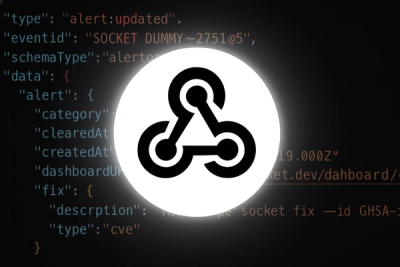
Product
Introducing Webhook Events for Alert Changes
Add real-time Socket webhook events to your workflows to automatically receive software supply chain alert changes in real time.
@mapbox/mapbox-sdk
Advanced tools
A JS SDK for working with Mapbox APIs.
Works in Node, the browser, and React Native.
As of 6/11/18, the codebase has been rewritten and a new npm package released.
The mapbox package is deprecated in favor of the new @mapbox/mapbox-sdk package.
Please read the documentation and open issues with questions or problems.
npm install @mapbox/mapbox-sdk
If you are supporting older browsers, you will need a Promise polyfill. es6-promise is a good one, if you're uncertain.
The documentation below assumes you're using a JS module system. If you aren't, read "Pre-bundled files on unpkg.com".
There are 3 basic steps to getting an API response:
To create a service client, import the service's factory function from '@mapbox/mapbox-sdk/services/{service}' and provide it with your access token.
The service client exposes methods that create requests.
const mbxStyles = require('@mapbox/mapbox-sdk/services/styles');
const stylesService = mbxStyles({ accessToken: MY_ACCESS_TOKEN });
// stylesService exposes listStyles(), createStyle(), getStyle(), etc.
You can also share one configuration between multiple services. To do that, initialize a base client and then pass that into service factory functions.
const mbxClient = require('@mapbox/mapbox-sdk');
const mbxStyles = require('@mapbox/mapbox-sdk/services/styles');
const mbxTilesets = require('@mapbox/mapbox-sdk/services/tilesets');
const baseClient = mbxClient({ accessToken: MY_ACCESS_TOKEN });
const stylesService = mbxStyles(baseClient);
const tilesetsService = mbxTilesets(baseClient);
To create a request, invoke a method on a service client.
Once you've created a request, send the request with its send method.
It will return a Promise that resolves with a MapiResponse.
const mbxClient = require('@mapbox/mapbox-sdk');
const mbxStyles = require('@mapbox/mapbox-sdk/services/styles');
const mbxTilesets = require('@mapbox/mapbox-sdk/services/tilesets');
const baseClient = mbxClient({ accessToken: MY_ACCESS_TOKEN });
const stylesService = mbxStyles(baseClient);
const tilesetsService = mbxTilesets(baseClient);
// Create a style.
stylesService.createStyle({..})
.send()
.then(response => {..}, error => {..});
// List tilesets.
tilesetsService.listTilesets()
.send()
.then(response => {..}, error => {..})
For more details, please read the full classes documentation.
MapiRequestService methods return MapiRequest objects.
Typically, you'll create a MapiRequest then send it.
send returns a Promise that resolves with a MapiResponse or rejects with a MapiError.
MapiRequests also expose other properties and methods that you might use from time to time.
For example:
MapiRequest#abort aborts the request.MapiRequest#eachPage executes a callback for each page of a paginated API response.MapiRequest.emitter exposes an event emitter that fires events like downloadProgress and uploadProgress.For more details, please read the full MapiRequest documentation.
// Create a request and send it.
stylesService.createStyle({..})
.send()
.then(response => {..}, error => {..});
// Abort a request.
const req = tilesetsService.listTilesets();
req.send().then(response => {..}, error => {
// Because the request is aborted, an error will be thrown that we can
// catch and handle.
});
req.abort();
// Paginate through a response.
tilesetsService.listTilesets().eachPage((error, response, next) => {
// Do something with the page, then call next() to send the request
// for the next page.
// You can check whether there will be a next page using
// MapiResponse#hasNextPage, if you want to do something
// different on the last page.
if (!response.hasNextPage()) {..}
});
// Listen for uploadProgress events.
const req = stylesService.createStyleIcon({..});
req.on('uploadProgress', event => {
// Do something with the progress event information.
});
req.send().then(response => {..}, error => {..});
MapiResponseWhen you send a MapiRequest, the returned Promise resolves with a MapiResponse.
Typically, you'll use MapiResponse.body to access the parsed API response.
MapiResponses also expose other properties and methods.
For example:
MapiResponse#hasNextPage indicates if there is another page of results.MapiResponse#nextPage creates a MapiRequest that you can send to get that next page.MapiResponse.headers exposes the parsed HTTP headers from the API response.For more details, please read the full MapiResponse documentation.
// Read a response body.
stylesService.getStyle({..})
.send()
.then(resp => {
const style = resp.body;
// Do something with the style.
}, err => {..});
// Get the next page of results.
tilesetsService.listTilesets()
.send()
.then(resp => {
if (resp.hasNextPage()) {
const nextPageReq = resp.nextPage();
nextPageReq.send().then(..);
}
}, err => {..});
// Check the headers.
tilesetsService.listTilesets()
.send()
.then(resp => {
console.log(resp.headers);
}, err => {..});
MapiErrorIf the server responds to your MapiRequest with an error, or if you abort the request, the Promise returned by send will reject with a MapiError.
MapiErrors expose the information you'll need to handle and respond to the error.
For example:
MapiError.type exposes the type of error, so you'll know if it was an HTTP error from the server or the request was aborted.MapiError.statusCode exposes the status code of HTTP errors.MapiError.body exposes the body of the HTTP response, parsed as JSON if possible.MapiError.message tells you what went wrong.For more details, please read the full MapiError documentation.
// Check the error.
stylesService.getStyle({..})
.send()
.then(response => {..}, error => {
if (err.type === 'RequestAbortedError') {
return;
}
console.error(error.message);
});
Please read the full documentation for services.
If you aren't using a JS module system, you can use a <script> tag referencing pre-bundled files on the CDN unpkg.com.
<script src="https://unpkg.com/@mapbox/mapbox-sdk/umd/mapbox-sdk.js"></script>
<script src="https://unpkg.com/@mapbox/mapbox-sdk/umd/mapbox-sdk.min.js"></script>
These files are a UMD build of the package, exposing a global mapboxSdk function that creates a client, initializes all the services, and attaches those services to the client.
Here's how you might use it.
<script src="https://unpkg.com/@mapbox/mapbox-sdk/umd/mapbox-sdk.min.js"></script>
<script>
var mapboxClient = mapboxSdk({ accessToken: MY_ACCESS_TOKEN });
mapboxClient.styles.getStyle(..)
.send()
.then(..);
mapboxClient.tilesets.listTilesets(..)
.send()
.then(..);
</script>
Please read ./docs/development.md.
Leaflet is an open-source JavaScript library for interactive maps. While it does not provide direct API services like geocoding or directions, it is highly customizable and can be integrated with various mapping services, including Mapbox. It is more focused on rendering and interacting with maps in the browser.
OpenLayers is another open-source JavaScript library for displaying map data in web browsers. It supports a wide range of map services and formats. Unlike @mapbox/mapbox-sdk, it does not provide direct API services but is highly flexible for creating custom map applications.
FAQs
JS SDK for accessing Mapbox APIs
The npm package @mapbox/mapbox-sdk receives a total of 187,122 weekly downloads. As such, @mapbox/mapbox-sdk popularity was classified as popular.
We found that @mapbox/mapbox-sdk demonstrated a healthy version release cadence and project activity because the last version was released less than a year ago. It has 28 open source maintainers collaborating on the project.
Did you know?

Socket for GitHub automatically highlights issues in each pull request and monitors the health of all your open source dependencies. Discover the contents of your packages and block harmful activity before you install or update your dependencies.

Product
Add real-time Socket webhook events to your workflows to automatically receive software supply chain alert changes in real time.

Security News
ENISA has become a CVE Program Root, giving the EU a central authority for coordinating vulnerability reporting, disclosure, and cross-border response.

Product
Socket now scans OpenVSX extensions, giving teams early detection of risky behaviors, hidden capabilities, and supply chain threats in developer tools.